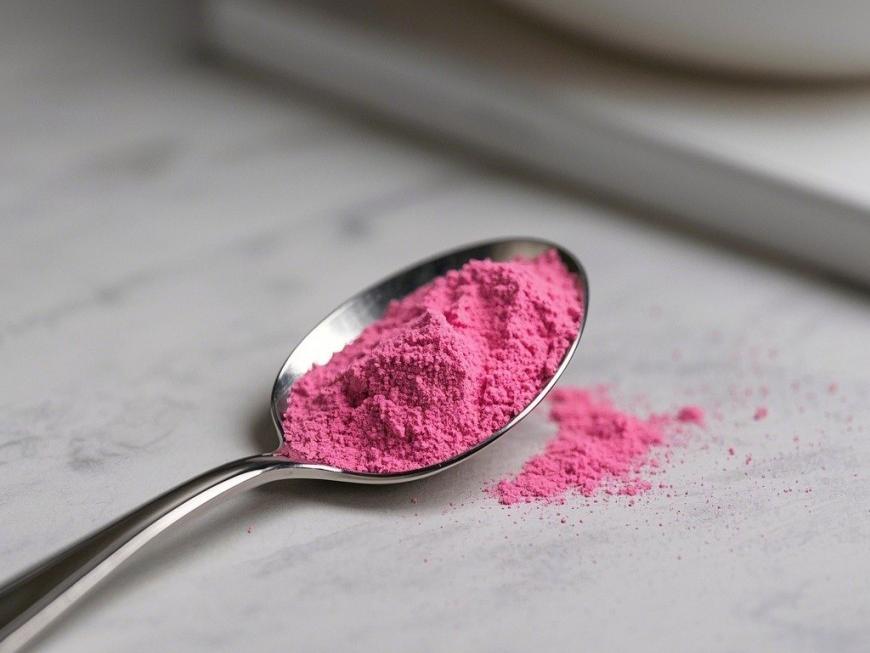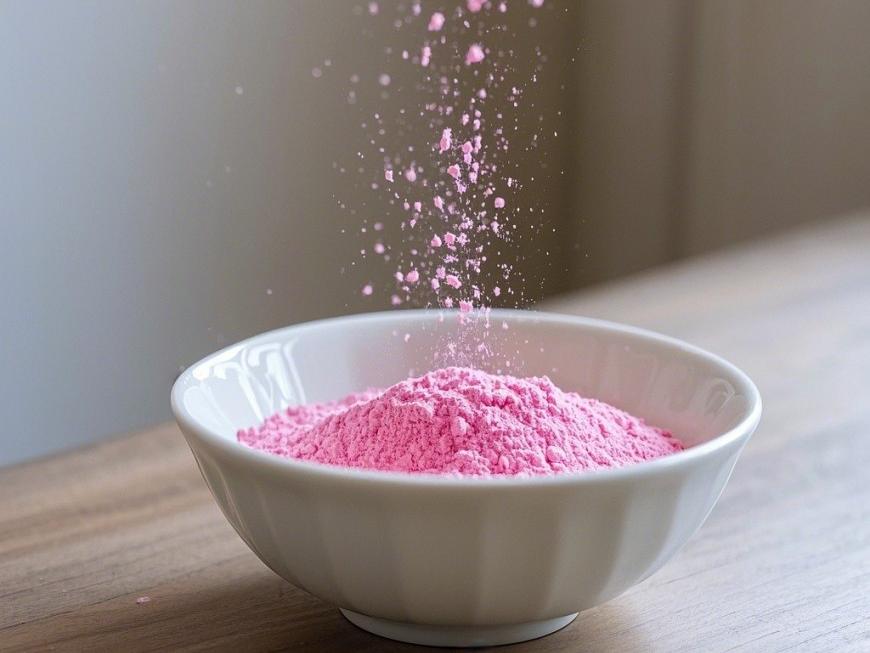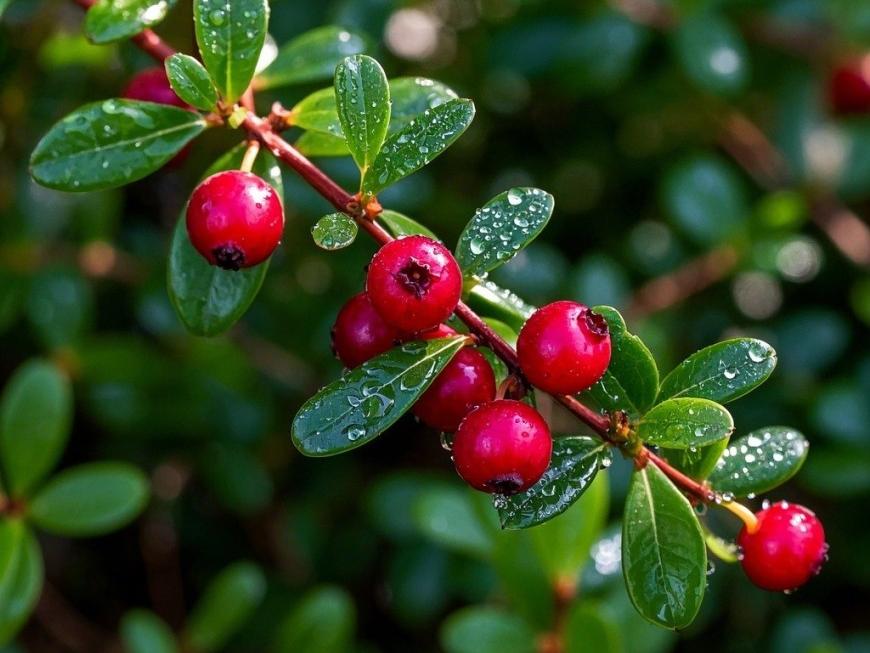What Is the Benefit of Cranberry in Telugu?
Cranberries in Telugu, are evergreen small shrubs of the genus Vaccinium (Vacinium macrocarpon) of the Ericaceae family. The plants are 5 to 20 cm high and the vine-like branches spread about 2 m. It has 5 to 10 mm oval-shaped leaves and dark pink flowers with with their curved petals and exposed stamens pointing forward. The whole plant looks like a crane, and the flowers resemble the head and beak of a crane, which is why cranberries are also called “craneberries”. Its fruit is an oval-shaped berry 2–5 cm long, which changes from white to dark red and has a slightly sweet and sour taste.
Cranberries grow in damp bogs and sandy soil. Their branches are rooted in a sandy soil bed made of acidic sand, and they take 3–5 years to mature and bear fruit. The growth period for cranberries is from March to September. In mid-July, the petals fall off and the fruit sprouts. The fruit is harvested from mid-September to mid-October. There are wet and dry harvesting methods. The majority of harvests are wet harvests. The fruit farmers flood the cranberry fields, causing the water to rise 15–20 cm above the cranberry vines. The cranberries then float to the surface, where the fruit farmers gather them in a circle and transport them to the truck on a conveyor belt. Dry harvests use a picking machine with a comb-like conveyor belt. The machine picks the cranberries off the branches and directly into sacks and then loaded onto trucks for transport [1]. Only 5% to 10% of the total mass of cranberries is harvested using the dry method, and they are mainly sold as fresh fruit.
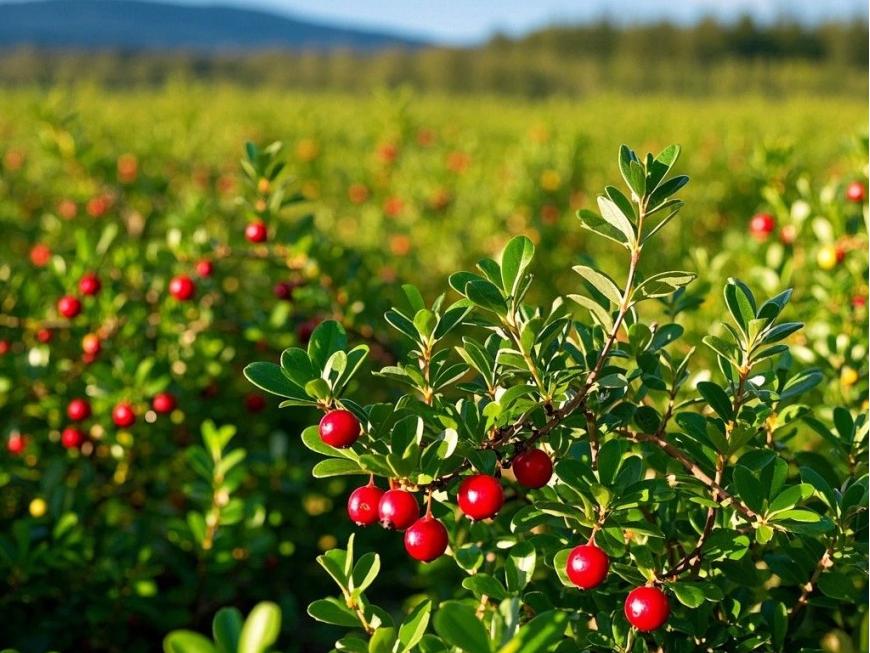
1 History of cranberries
Cranberries in Telugu have a long history of cultivation on the North American continent, and the local Native American tribes were the first to eat them. They made jam and dried cranberries, and used cranberry juice to treat wounds and dye fabrics. In the 15th century, when European colonists first set foot on the North American continent, they suffered from various illnesses due to the unfamiliar environment. The Indians introduced cranberries to the settlers, and the health benefits of cranberries played a significant role in the recovery of the European settlers' health. They fell in love with these cranberries and promoted their cultivation, and soon invented new cranberry food recipes, including sauces, pies and juices, and also made them a Thanksgiving food.
The settlers exported cranberries to Europe and offered them as tribute to the European aristocracy in Telugu. In 1677, the colonial government of New England offered the British king three native American products as tribute: Indian corn, codfish and cranberries. However, after the long voyage, the codfish and corn had rotted, and only the cranberries were presented to the king in their original state. Since then, cranberries have become famous for their ability to retain freshness and resist decay.
300 years ago, a New Jersey captain took a large quantity of dried cranberries with him on a voyage to feed his sailors, and accidentally discovered that cranberries could cure scurvy. Since then, cranberries have been prized as a food that prevents scurvy. During the American War of Independence, a veteran named Henry Hall established a cranberry farm in the town of Dennis in Massachusetts, which is the earliest record of commercial cranberry cultivation [2]. Over the next 200 years, as cultivation techniques improved and the health benefits of cranberries were discovered, more and more people became aware of the health benefits of cranberries, and the scale of cultivation and production continued to increase. By 2008, the world's cranberry cultivation area had reached 41.62×104 hm2, with about 1,200 growers and total sales of over 1.5 billion US dollars[3].
Cranberries mainly grow in the cold northern hemisphere, limited to the northern United States in Massachusetts, Wisconsin, Maine, etc., and Quebec, Columbia, and Chile in South America, as well as a small area in northeastern Europe. The United States accounts for 95% of the world's production, with Wisconsin ranking first in production, accounting for 50% of the total U.S. production, and Massachusetts, ranking second, accounting for 28% of the total production [4]. The growth in production is due to the continued increase in demand for cranberry products. Since cranberry fruits are not resistant to storage and transportation, they are usually sold as frozen fruits or processed into products such as cans, jams and juices.
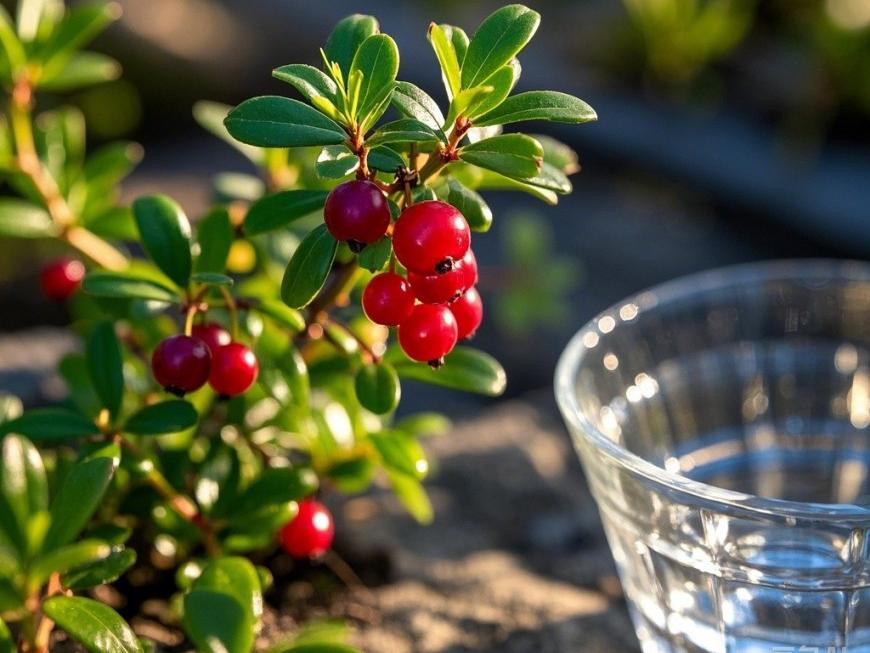
As can be seen from Table 1, the demand for cranberries is increasing year by year both worldwide and in China. In 2006, world demand was 3.47 billion US dollars, and in 2010 it exceeded 4.2 billion US dollars.
In China, cranberries are still in the wild, with only some wild species distributed in the northeast and other places. The breeding and cultivation of cranberries has just begun. With the rapid growth of market demand, some domestic research institutes have also begun to select, introduce and breed cranberries[6].
2 Main nutrients in cranberries
Table 2 shows that cranberries are low in calories, high in fiber, and rich in vitamins and minerals. High dietary fiber content can promote intestinal detoxification, prevent constipation, prevent colon cancer, and treat diabetes; VC can prevent scurvy, promote growth and development, enhance physical strength, and relieve fatigue; high potassium and low sodium foods are beneficial to patients with hypertension; VA can maintain normal visual function and enhance immunity. Compared to other fruits, cranberries have a high nutrient content and are healthier for the body.
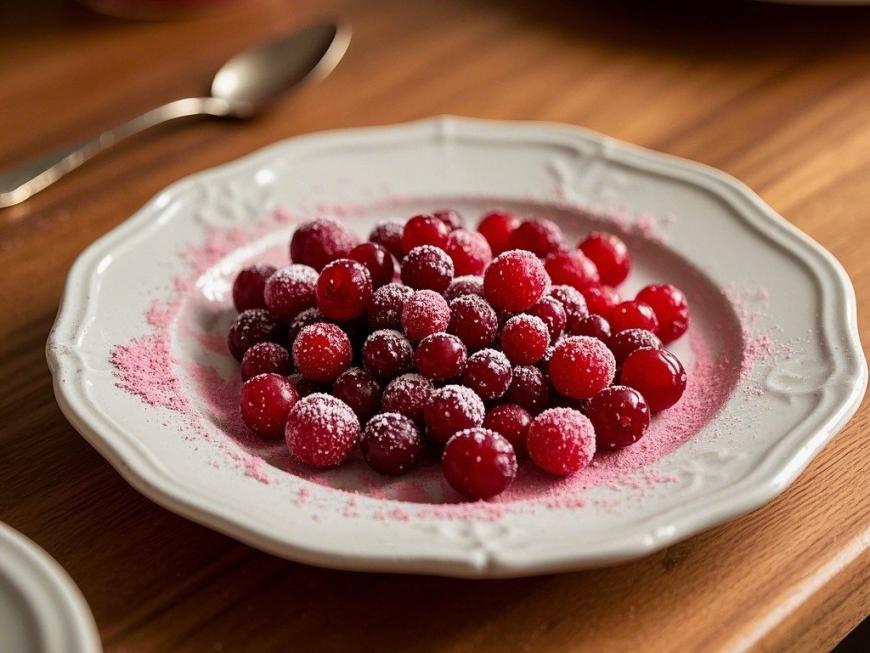
3 Functional properties of cranberries
3.1 Prevention of urinary tract infections
The most unique effect of cranberries is that they can effectively prevent urinary tract infections (UTIs). Escherichia coli causes 80% to 90% of UTIs. Domestic and foreign scholars have been studying the mechanism of this function for many years. In the early days, it was believed that the various acidic substances in cranberries can increase the acidity of urine in the bladder, creating a strongly acidic environment that kills E. coli in the urethra [8].
In 1998, a study by New Jersey State University scientists Howell A B and others confirmed for the first time that the active substance in cranberries responsible for inhibiting urinary tract infections is concentrated tannic acid or proanthocyanidins (PACs) isolated from cranberries. Proanthocyanidins are concentrated tannic acids, mainly oligomers or polymers of epicatechin and epigallocatechin. The proanthocyanidins in cranberries contain 34.3 mg/100 g. Numerous studies have shown that it has anti-bacterial adhesion properties, which can prevent pathogenic bacteria such as Escherichia coli from adhering to the epithelial cells of the urinary tract and the bladder wall. The pathogenic bacteria are flushed away with the urine, thereby preventing urinary tract infections [9].
Foo LY et al. [10] used 13C nuclear magnetic resonance spectroscopy, electron emission mass spectrometry and other methods to detect the structure of proanthocyanidins in cranberries and found that it is different from the proanthocyanidins in apples, grapes and green tea. The proanthocyanidins in these plants all have flavan bonds connected by type B, while the proanthocyanidins in cranberries contain one or more flavan bonds connected by type A. This unique A-type structure can compete with the exogenous lectin on the bacterial cilia, preventing the bacteria from binding to the cell receptor. This competitive inhibition is an effective anti-bacterial adhesion property. Currently, only a few plants have this type of proanthocyanidin structure.
Many researchers have conducted clinical trials and population-based tests on cranberries for their ability to prevent urinary tract infections. David T Bailey et al. [11] selected susceptible women aged 25 to 70 years with a history of urinary tract infections. Before the test, the researchers tested their urine, then had them take capsules containing 200 mg of cranberry concentrate twice a day for 12 weeks. They were then asked about their health every month and their urine was tested for comparison for 2 years. The results showed that during the 12 weeks of taking the capsules and for 2 years after they stopped taking them, these women did not suffer from any further urinary tract infections.
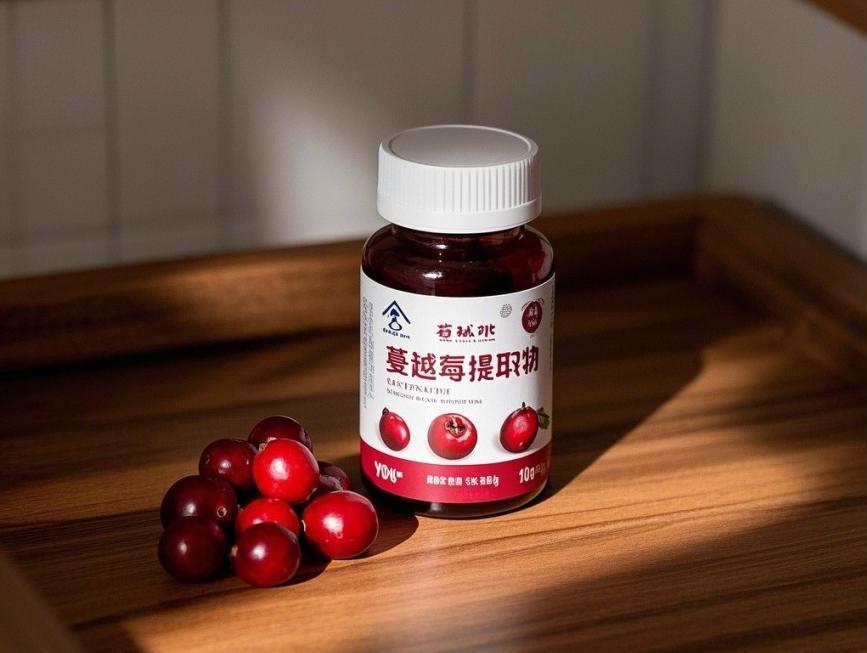
Avorn J et al. [12] conducted a randomized controlled trial with 153 elderly female volunteers and found that women who drank 300 mL of cranberry juice a day had a 27% lower risk of recurrent urinary tract infections than the control group (p=0.0106).
Greenberg J A et al. [13] conducted a small comparative test with 5 people, who consumed dried cranberries and raisins respectively, and then tested the adhesion of E. coli in their urine. The results showed that the adhesion of E. coli in the urine of the test subjects who consumed dried cranberries was significantly reduced, indicating that dried cranberries are effective in inhibiting the adhesion properties of E. coli.
3.2 Anti-Helicobacter pylori
Cranberries contain proanthocyanidins, ellagic acid, phenolic acids, resveratrol and other substances with antibacterial properties. Many studies have shown that cranberries can inhibit Helicobacter pylori infection and are effective in preventing stomach ulcers, stomach cancer and duodenal ulcers.
Matsushima M et al. [14] showed that cranberry extract can inhibit the proliferation of Helicobacter pylori, and that the polyphenols in the extract play a key role. Cell morphology analysis showed that substances in cranberries induce Helicobacter pylori to develop into spherical shapes, thereby inhibiting the reproduction of Helicobacter pylori.
Ora Burger et al. [15] studied the changes in the adhesion ability of Helicobacter pylori to gastric juice and red blood cells in the presence of high concentrations of cranberry extract. The results showed that high concentrations of cranberry extract can effectively inhibit the adhesion ability of Helicobacter pylori and prevent diseases such as gastric ulcers caused by Helicobacter pylori.
Zhang et al. [16] conducted a clinical trial on cranberries against H. pylori in Shandong Province. 189 H. pylori-infected people were divided into 2 groups: 97 people drank 250 mL of cranberry juice daily, and 92 people drank an equivalent dose of a control agent. After 90 days, these infected people were tested for infection using the carbon-13 urea breath test. The results showed that 14 people (14.43%) in the cranberry juice group had negative urea breath tests (elimination of infection), while only 5 people (5.44%) in the control group had negative urea breath tests. There was a significant difference between the two groups. This indicates that cranberry juice can inhibit the infection of Helicobacter pylori in the population.
3.3 Antioxidant
Mao Guangming et al. [18] used mice with two models of natural aging and radiation to feed different doses of cranberries, and after 30 days, the activity of superoxide dismutase (SOD) and glutathione peroxidase (GSH2Px) and the content of malondialdehyde (MDA) in mouse blood and liver tissue were measured. The results showed that cranberries significantly enhanced the activity of SOD and GSH2Px in mouse blood and liver tissue, and reduced the content of MDA in mouse blood and liver tissue. This indicates that cranberries can improve the body's antioxidant capacity in both naturally aging and irradiated mice.
Reed J et al. [19] found that the flavonoids in cranberries have antioxidant properties in both in vivo and in vitro tests, and that flavonols and proanthocyanidins in particular have a preventive effect on atherosclerosis.
3.4 Antitumor
The antioxidant components in cranberries can remove free radicals and mutated cells in the human body, and are effective in preventing cancer and killing cancer cells.
Catherine Neto et al. [20] extracted proanthocyanidins and other substances from cranberries and then tested their effects on various cancer cells. The results showed that the extract had a toxic effect on lung cancer cells, colon cancer cells, and leukemia cancer cells, significantly inhibiting the growth of these cancer cells, while having no toxic effect on other healthy cells.
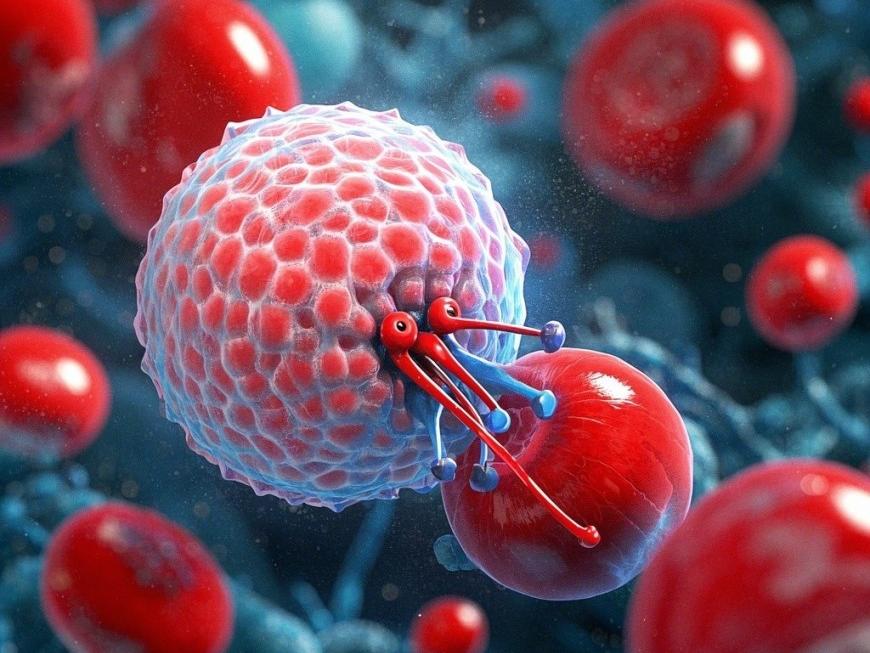
Ferguson et al. [21] extracted anthocyanins and other flavonoids from dried cranberries and fed them to mice implanted with breast cancer cells. After a period of feeding, it was found that the spread of cancer cells in the mice was limited and slowed down, and the tumors shrank.
Sun et al. [22] confirmed in their research that cranberry nutritional extracts inhibit the growth of breast cancer cells in two ways: ① inducing cancer cell suicide; and ② preventing the completion of cancer cell reproductive replication, thereby inhibiting their growth.
3.5 Prevention of cardiovascular disease
Cranberries contain a variety of flavonol compounds such as hyperoside, pentahydroxyflavone and myricetin, which, together with anthocyanins, determine the color of the cranberry fruit. Flavonols have strong antioxidant activity, inhibit the oxidation of low-density lipoprotein cholesterol, lower the level of triglycerides in the blood, and help promote cardiovascular health.
Wilson [23] showed that cranberry juice and extracts can reduce the oxidation of low-density cholesterol.
Reed [24] conducted an animal experiment on pigs, which showed that cranberry juice can reduce the total cholesterol content in pig blood. In particular, the higher the initial total cholesterol level, the greater the decrease in cholesterol levels after consumption, and the better the effect.
Caron [25] conducted a population test in which participants were asked to compare drinking low-energy cranberry juice with other drinks and their cholesterol levels were tested after 28 days. The results showed that the total cholesterol and low-density cholesterol levels in the blood of participants who drank cranberry juice decreased significantly, while the triglyceride and high-density cholesterol levels did not change.
Kruse-Elliott et al. [26] showed that cranberries not only increase the level of high-density cholesterol, but also maintain cardiovascular function, which is beneficial for patients with atherosclerosis.
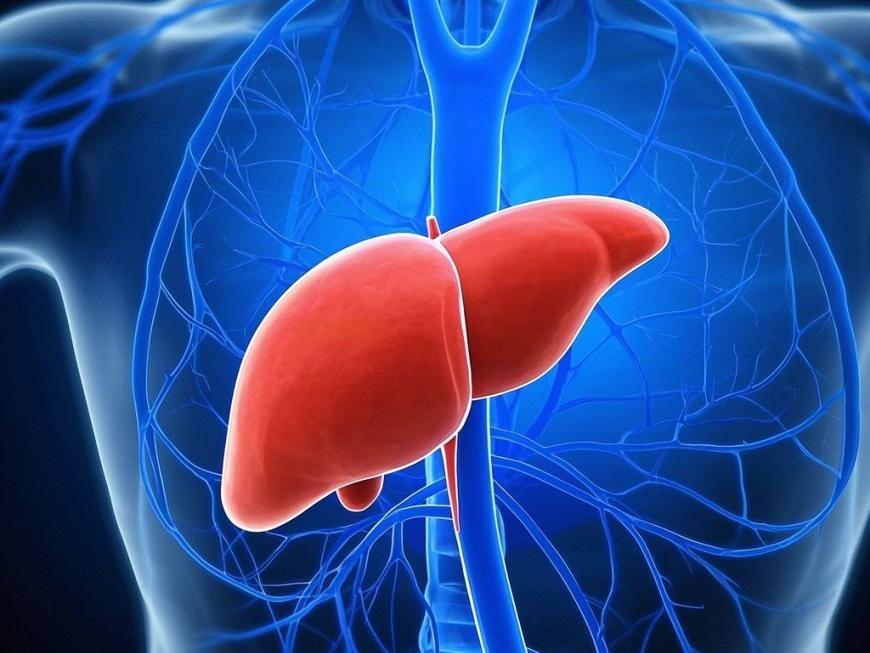
3.6 Protection of the mouth and teeth
Koo et al. [27] found that substances isolated from cranberry juice can break down the flora in the mouth, in particular Streptococcus mutans in saliva, which causes tooth decay and plaque, thereby protecting the teeth. Hyun investigated the mechanism of action of cranberries against tooth decay and found that cranberry juice prevents tooth decay by preventing Streptococcus mutans from adhering to the tooth surface and inhibiting its reproduction.
Weiss et al. [28] conducted a preliminary clinical study in which test subjects used mouthwash containing cranberry concentrate (a non-dialyzable macromolecule) and ordinary mouthwash. The results showed that the test subjects using cranberry mouthwash had a two-order-of-magnitude reduction in Streptococcus mutans in the mouth, effectively protecting the mouth.
3.7 Lowering blood pressure
Cranberries' low sodium and high potassium properties make them effective in lowering blood pressure. Maher et al. [29] conducted an experiment on rats in which cranberry juice was injected intravenously and found that the rats' blood pressure decreased. They also tested the effect of cranberry juice on nitric oxide production in arterial endothelial cells. The study found that cranberry juice can promote the production of nitric oxide in vascular endothelial cells, relax blood vessels, and thus lower blood pressure. This helps explain how cranberries can help promote a healthy blood pressure level.
Apostolidis et al. [30] used water-soluble cranberry extracts combined with oregano, rosemary and rhodiola as ingredients to measure their inhibitory effects on α-glucosidase, pancreatic α-amylase and ACE-1, to evaluate their antioxidant activity, as well as their effects on diabetes and anti-hypertension. The results showed that the ability of different ingredients to inhibit α-glucosidase, pancreatic α-amylase, and ACE-1 was significantly enhanced when combined with cranberry extract, indicating that cranberry extract has antioxidant properties and can lower blood pressure and prevent diabetes.

In addition, cranberries have a variety of other health benefits, such as laxative, lowering cholesterol, preventing heart disease, preventing atherosclerosis, antioxidant, antitumor, antiviral, liver protection, anti-ulcer.
4 Application of cranberry products
Cranberry products in Telugu are available in a variety of forms and have a wide range of applications, so they have good prospects for promotion.
With the rapid development of the cranberry industry and the food nutrition industry's promotion of its powerful health benefits, cranberries will become more and more well-known and popular, and the various products derived from them will also become popular.
References:
[1] Wan Xuedao. North American super-small fruit tree - cranberry [J]. China Forestry, 2002 (1): 41.
[2] Hua Meiyuan. Falling in love with cranberries [J]. Health Vision: Medical Supplement, 2007 (8): 45-49.
[3]Gary R Keough. Massachusetts and maine cranberries [G].NASS:New England Agricultural Statistics, USDA, 2008:42-44.
[4]Larisa Pozdnyakova , Daniel Giménez , Peter V. Oude - mans,spatial analysis of cranberry yield at three scales [J] . Agron J , 2005 (97):49-57.
[5]Philip M. The 2006 - 2011 world outlook for canned cran- berries and cranberry [EB/OL]. [2005-7-19]http:// www.icongrouponline.com.
[6] Yang Jinghui, Li Jianke, et al. History, current situation and development trend of cranberry cultivation [J]. Journal of Tianjin Academy of Agriculture, 2009 (3): 48-50.
[7]Oxygen Radical Absorbance Capacity of Selected Foods - 2007 [ R] : Nutrient Data Laboratory , Agricultural Research Service , United States Department of Agriculture , November 2007.
[8]Bodel P I , Cotrain R , and Kass E H. Cranberry juice and the antibacterial action of hippuric acid [J] . Journal of Laboratory and Clinical Medicine , 1959 (54): 881 - 888.
[9] Howell A.B , Vorsa N , Marderosian A.D , et al. Inhib- ition of the adherence of P -fimbriated Escherichia coli to uroepithelial -cell surfaces by proanthocyanidin extracts from cranberries [J] . New England Journal of Medicine (Letter),1998 ,339 (15):1 085-1 086.
[10]Foo L Y , Lu Y , Howell A B , et al. The structure of cranberry proanthocyanidins which inhibit adherence of uropathogenic P-fimbriated Escherichia coli in vitro [J]. Phytochemistry , 2000 ,54 (2):173-181.
[11]David T. Bailey. Can a concentrated cranberry extract pre- vent recurrent urinary tract infections in women? A pilot study [J] . Phytomedicine ,2007 ,14 (4):237-241.
[12]Avorn J. Reduction of Bacteriuria and Pyuria after Inges- tion of Cranberry Juice [J] . JAMA , 1994 ,271 (10): 751-754.
[13]Greenberg J A, Newmann S J,Howell A B. Consu-mption of sweetened dried cranberries versus unsweetened raisins for inhibition of uropathogenic Escherichia coli adhesion in human urine: a pilot study [J] . Journal of Alternative and Complementary Medicine ,2005 (11): 875-878.
[14]Howell A B. Cranberry juice and adhesion of antibiotic-re- sistant uropathogens [J] . JAMA,2002,287 (23):3 082- 3 083.
[15]Ora Burger. A high molecular mass constituent of cranberry juice inhibit Helicobacter pylori adhesion to human gastric mucus [J] . FEMS Immunology and Medical Microbiolo- gy , 2000 , 29 (4):295-301.
[16]Zhang L. Efficacy of cranberry juice on Helicobacter pylori Infection: a double -blind , randomized placebo -con- trolled trial [J] . Helicobacter. 2005 (10):139-145.
[17]Halvorsen B L ,Carlsen M H , Phillips K M , et al. Con- tent of redox-active compounds (ie antioxidants) in foods consumed in the United States [J] . Am J Clin Nutr 2006
(84):95-135.
[18] Mao Guangming. Effect of cranberry on the antioxidant function of aging mice and irradiated mice [J]. Zhejiang Preventive Medicine, 2007, 19 (5): 10-12.
[19]Reed J. Cranberry flavonoids , atherosclerosis and cardio- va-scular health [J] . Crit Rev Food Sci Nutr , 2002 , 42 (3) :301-316.
[20]Neto C. MALDI -TOF MS characterization of proanthoc - yanidins from cranberry fruit (Vaccinium macrocarpon) that inhibit tumor cell growth and matrix metalloproteinase expression in vitro [J]. Journal of the Science of Food and Agriculture , 2006 ,86 (1):18-25.
[21]Ferguson P J , Kurowska E , Freeman D J ,et al. A flav- onoid fraction from cranberry extract inhibits proliferation of human tumor cell lines [J] . Nutr. 2004 , 134 (6): 29-35.
[22]Sun J , Hai Liu R. Cranberry phytochemical extracts in- duce cell cycle arrest and apoptosis in human MCF -7 breast cancer cells [J]. Cancer Letters. 2005 , 241(1):124-134.
[23]Wilson T , Porcari J P , Harbin D. Cranberry extract in- hibits low density lipoprotein oxidation [J]. Life Sci. 1998 (62):381-386.
[24]Reed J. Cranberry flavonoids , atherosclerosis , and car- diovascular health [J] . Crit Rev Food Sci Nutr. 2002,(42):301-316.
[25]Caron A D , Kautza B C , Wilson T. Cholesterol lowering effect of low calorie cranberry juice in humans [J]. FASEB , 2005 (19):1009-1010.
[26]Kruse -Elliott K , Reed J. Cranberry juice modulates athero-sclerotic vascular dysfunction [C] . Paper present- ed at the 35th Congress of the International Union of Physiological Sciences in San Diego ,CA ,2005-08-03.
[27]Koo H , Nino de Guzman P , Schobel B D , et al. Influ- ence of cranberry juice on glucan-mediated processes in- volved in Streptococcus mutans biofilm development [J] . Caries Res. 2006 , 40 (1):20-27.
[28]Weiss E I , Lev-Dor R , Sharon N , et al. Inhibitory Ef- fect of high-molecular-weight constituent of cranberry on adhesion of oral bacteria [J] . Food Science & Nutrition, 2002,(42):285-292.
[29]Maher M A , Mataczynski H , Stefaniak H M , et al. Cranberry juice induces nitric oxide -dependent vasodila- tion in vitro and its infusion transiently reduces blood pressure in anesthetized rats [J].Med Food. 2000,(3): 141-147.
[30]Apostolidis E. Potential of cranberry-based herbal syner- gies for diabetes and hypertension management [J] . Asia Pac J Clin Nutr. 2006 , 15 (3):433-441.


 English
English French
French Spanish
Spanish Russian
Russian Korean
Korean Japanese
Japanese